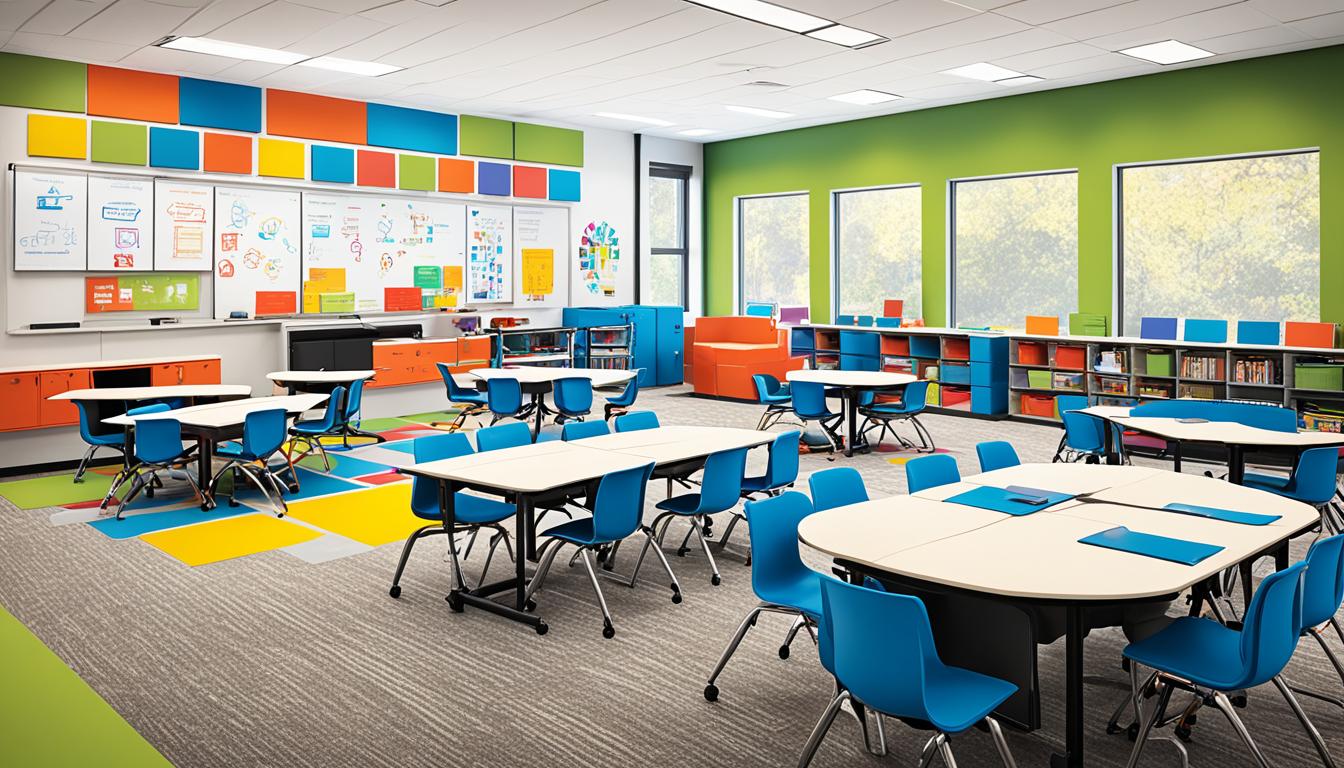In today’s rapidly evolving world, the field of education is experiencing a significant shift. Traditional methods of teaching and learning are being challenged as educators seek to provide transformative learning experiences for students. To achieve educational excellence, innovative models are being developed and implemented to meet the diverse needs and aspirations of learners.
Transforming learning involves embracing new approaches that go beyond the confines of the traditional classroom. By harnessing the power of technology, educators can create dynamic and interactive learning environments that engage students and foster their intellectual growth. These innovative models focus on personalized instruction, adaptive learning technologies, game-based learning, and the use of virtual and augmented reality.
By adopting these innovative models, educational institutions can enhance learning outcomes and prepare students to thrive in the digital age. These approaches offer flexibility, promote critical thinking and creativity, and facilitate the acquisition of essential skills for future success.
In this article, we will explore the concept of transforming learning and the importance of innovative models in achieving educational excellence. We will delve into specific examples of these models and examine their impact on student engagement and achievement. By embracing these new approaches, we can truly transform the educational landscape and empower students to reach their full potential.
Key Takeaways:
- Transforming learning involves adopting innovative models to create transformative learning experiences.
- Innovative models focus on personalized instruction, adaptive learning technologies, game-based learning, and the use of virtual and augmented reality.
- These models enhance learning outcomes, promote critical thinking and creativity, and equip students with essential skills for the future.
- By embracing innovative models, educational institutions can empower students to reach their full potential in the digital age.
- The implementation of innovative models requires a collaborative effort between educators, administrators, and policymakers.
The Role of the U.S. Department of Education in Fostering Higher Education Excellence
In the pursuit of higher education excellence, the U.S. Department of Education plays a crucial role in fostering a supportive and transformative educational ecosystem. Through various initiatives and proven strategies, the department is committed to raising the bar and leading the world in education.
“Raise the Bar: Lead the World” Initiative
As part of its mission to advance educational equity and excellence, the U.S. Department of Education launched the “Raise the Bar: Lead the World” initiative. This initiative aims to set high standards and expectations for educational institutions, empowering them to provide a world-class education to students from all backgrounds.
The “Raise the Bar: Lead the World” initiative focuses on:
- Establishing rigorous academic standards that promote critical thinking and problem-solving skills.
- Investing in teacher training and professional development to ensure educators are equipped with the knowledge and skills necessary to deliver high-quality instruction.
- Implementing evidence-based instructional practices that have proven effective in driving academic success.
- Developing comprehensive assessment systems that provide valuable insights into student learning and inform instruction.
- Promoting educational innovation and embracing emerging technologies to enhance teaching and learning experiences.
Proven Strategies for Academic Success
The U.S. Department of Education recognizes the importance of implementing proven strategies for academic success. These strategies encompass a range of approaches that have demonstrated positive outcomes in fostering student achievement and promoting excellence in higher education.
Some of the proven strategies for academic success include:
- Early intervention programs that identify and support students at risk of falling behind.
- Mentoring and tutoring initiatives that provide additional guidance and support to students.
- Providing access to quality resources, such as libraries, technology, and research facilities.
- Implementing comprehensive student support services, including counseling and career guidance.
- Collaboration between educational institutions and industry partners to bridge the gap between academic learning and real-world applications.
By leveraging these strategies, the U.S. Department of Education aims to ensure that every student has access to a high-quality education that prepares them for future success.
| Benefits of U.S. Department of Education Initiatives | Description |
|---|---|
| Enhanced Educational Equity | The initiatives promote equitable access to quality education for students from diverse backgrounds. |
| Improved Teaching Standards | Through professional development opportunities, teachers gain the necessary skills and knowledge to excel in the classroom. |
| Elevated Academic Performance | The proven strategies implemented by the department contribute to improved student outcomes and academic success. |
| Global Competitiveness | By raising educational standards, the U.S. remains competitive on a global scale, producing highly skilled graduates. |
Rethinking Educational Delivery with Blended and Online Learning Models
Traditional educational delivery methods are being revolutionized by the emergence of blended and online learning models. These innovative approaches to education offer transformative experiences for students, fostering flexible, personalized, and accessible learning opportunities.
Blended learning combines face-to-face instruction with online components, allowing students to engage with course materials and participate in discussions outside of the traditional classroom setting. This approach provides students with the flexibility to learn at their own pace while still benefiting from in-person interactions with their peers and instructors.
Online learning models, on the other hand, offer complete flexibility and accessibility as students can access educational materials and participate in virtual classrooms from anywhere in the world. This model eliminates barriers such as geographical constraints, making education more inclusive and accessible to a diverse range of students.
Blended and online learning models have the potential to transform education by:
- Providing personalized learning experiences tailored to individual students’ needs and learning styles
- Offering flexibility in terms of time and location, allowing students to learn at their own pace and convenience
- Increasing student engagement through interactive multimedia elements and collaborative online platforms
- Enabling efficient and effective assessment and feedback mechanisms to track student progress
- Promoting digital literacy skills that are essential in today’s technology-driven world
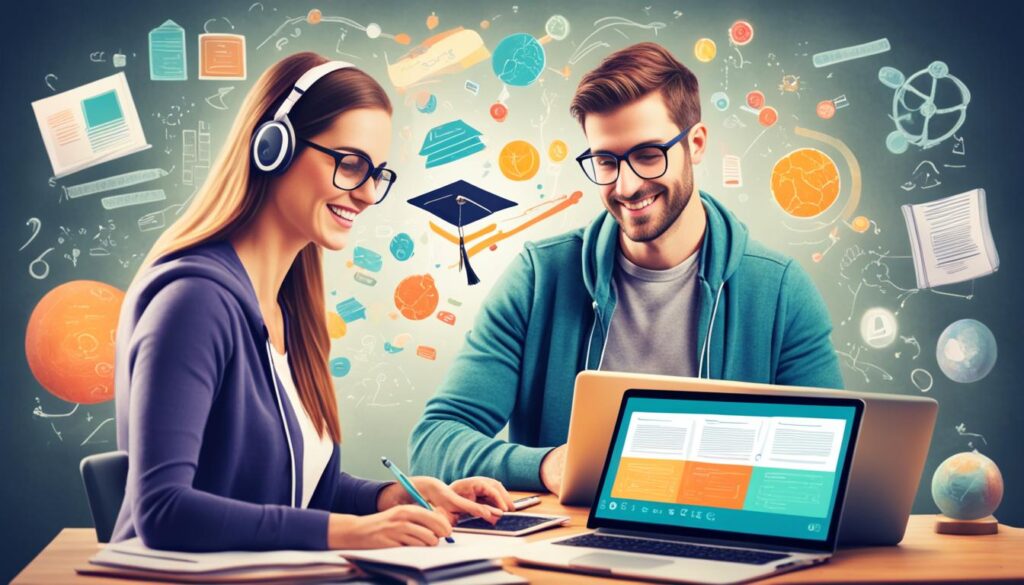
Blended and online learning models are reshaping the landscape of education, providing transformative opportunities for students to engage in meaningful and interactive learning experiences. As technology continues to advance, these models will further enhance their effectiveness and potential, ensuring that education remains accessible, engaging, and relevant in the digital age.
Personalizing the Educational Journey with Adaptive Learning Technologies
In today’s rapidly evolving educational landscape, personalized education has emerged as a powerful approach to meet the unique needs and abilities of individual students. One of the key drivers behind personalization is the integration of adaptive learning technologies, which leverage data analytics to tailor student learning experiences.
Adaptive learning technologies use algorithms and machine learning to analyze student data, including performance, preferences, and learning styles. By gathering insights from this data, educators can design custom learning pathways that cater to each student’s strengths, weaknesses, and interests. This tailored approach empowers students to learn at their own pace, resulting in improved engagement and academic outcomes.
The Power of Data Analytics in Tailoring Student Learning
Data analytics plays a crucial role in the personalization of student learning. By collecting and analyzing vast amounts of student data, educators can gain valuable insights into their learners’ progress and identify areas where additional support may be needed. This enables them to make data-driven decisions and provide targeted interventions for optimal learning outcomes.
Through data analytics, educators can also identify patterns and trends in student performance, enabling them to fine-tune their instructional strategies and adapt to individual needs. This iterative process of collecting, analyzing, and applying data creates a continuous feedback loop that enhances the efficacy of teaching and learning.
Case Study: The Success of Khan Academy’s Personalized Approach
“The mission of Khan Academy is to provide a free, world-class education for anyone, anywhere.”
– Salman Khan, Founder of Khan Academy
A noteworthy example of personalized education through adaptive learning technologies is Khan Academy. With its extensive library of educational content, Khan Academy uses data analytics to offer tailored learning experiences to millions of learners worldwide.
By tracking each student’s progress and performance, Khan Academy’s adaptive learning platform delivers personalized recommendations for targeted practice, remediation, and enrichment. This data-driven approach helps students build a solid foundation in key subjects and progress at their own pace, fostering a sense of ownership and empowerment in their educational journey.
Khan Academy’s success demonstrates the transformative impact of personalized education and the role that adaptive learning technologies and data analytics play in optimizing student learning outcomes.
| Benefits of Personalized Education with Adaptive Learning Technologies | Examples |
|---|---|
| Individualized learning paths tailored to students’ abilities and interests | Khan Academy’s adaptive learning platform |
| Improved engagement and motivation | Smart Sparrow’s adaptive courseware |
| Evidence-based decision-making for educators | Data-driven insights from DreamBox Learning |
| Efficient use of instructional time | ALEKS adaptive learning system |
By leveraging the power of adaptive learning technologies and data analytics, we can personalize the educational journey, enabling every student to reach their full potential. As the field continues to evolve, it is crucial for educators and institutions to embrace these transformative approaches and ensure that personalized education becomes a cornerstone of modern learning.
The Emergence of Game-Based Learning and Its Impact on Engagement
In recent years, game-based learning has gained traction as an innovative approach to education, transforming the way students engage with and absorb information. By incorporating elements of play and interactivity, game-based learning has proven to be a powerful tool in fostering student engagement and enhancing the learning experience.
Educational Breakthroughs with Minecraft Education Edition
A notable example of game-based learning is Minecraft Education Edition, a version of the popular sandbox game specifically designed for educational purposes. It provides students with a unique platform to explore, create, collaborate, and solve problems in a virtual environment.
With Minecraft Education Edition, educators can tailor lessons to align with various subjects and learning objectives. Whether it’s history, science, mathematics, or language arts, students can immerse themselves in virtual worlds that bring concepts to life, making the learning process more engaging and memorable.
The game-based nature of Minecraft Education Edition encourages critical thinking, problem-solving, creativity, and collaboration. Students can work together in teams, hone their communication skills, and develop a deeper understanding of complex concepts through hands-on experiences.
With its proven effectiveness in the classroom, Minecraft Education Edition has demonstrated the potential of game-based learning in fostering student engagement and creating an immersive learning environment.
The Gamification of Language Learning through Duolingo
Another remarkable example of game-based learning is Duolingo, a language-learning platform that has gamified the process of acquiring new language skills. Duolingo offers a range of interactive exercises, challenges, and rewards to motivate learners to continually progress and engage with the material.
By transforming language learning into an enjoyable and interactive experience, Duolingo captivates learners and encourages regular practice. The gamified approach stimulates learners’ curiosity, nourishes their competitive spirit, and keeps them motivated to achieve mastery.
Through gamification, Duolingo provides learners with a sense of accomplishment as they complete levels, earn virtual currency, and unlock new content. This element of achievement and progress drives engagement and instills a sense of confidence and pride in learners as they see their language skills improve over time.
The gamified structure of Duolingo also fosters a sense of community among learners. The platform allows users to compete with friends, share achievements, and receive feedback, creating a supportive and collaborative language-learning ecosystem.
Overall, the gamification of language learning through Duolingo demonstrates how game-based approaches can revolutionize the educational landscape, making learning more enjoyable, effective, and accessible to a wide range of learners.
| Educational Game-based Learning Solutions | Description | Benefits |
|---|---|---|
| Minecraft Education Edition | A game-based platform where students can explore, create, and collaborate in virtual worlds. |
|
| Duolingo | A gamified language-learning platform that offers interactive exercises and challenges. |
|
Technology’s Role in Expanding Accessibility to Quality Higher Education
In today’s digital age, technology is playing a crucial role in expanding accessibility to quality higher education. Various online platforms and virtual classrooms have emerged as revolutionary solutions, breaking down barriers and democratizing education for individuals around the world. One such platform that has been at the forefront of this movement is Coursera.
Breaking Down Barriers with Coursera’s Online Platform
Coursera, an online learning platform founded in 2012, has been instrumental in making education accessible to millions of learners. With over 190 partner institutions and thousands of courses, Coursera offers a wide range of subjects and disciplines, making it possible for learners to access quality education regardless of their geographical location or financial constraints.
Through Coursera, learners can access courses from top universities and institutions, gaining knowledge and skills that were once out of reach. The platform provides a flexible learning experience, allowing individuals to learn at their own pace and convenience. With Coursera, geographical barriers are no longer an obstacle for individuals seeking higher education.
Virtual Classrooms and the Democratization of Education
In addition to providing access to courses from prestigious institutions, Coursera offers virtual classrooms where learners can engage with instructors and fellow students. These virtual classrooms create a sense of community and facilitate collaborative learning, simulating the experience of a traditional classroom setting.
Furthermore, virtual classrooms open up opportunities for individuals who may face physical limitations or other constraints that hinder their ability to attend in-person classes. This technology-driven approach to education is breaking down even more barriers, ensuring that education is inclusive and accessible to all.
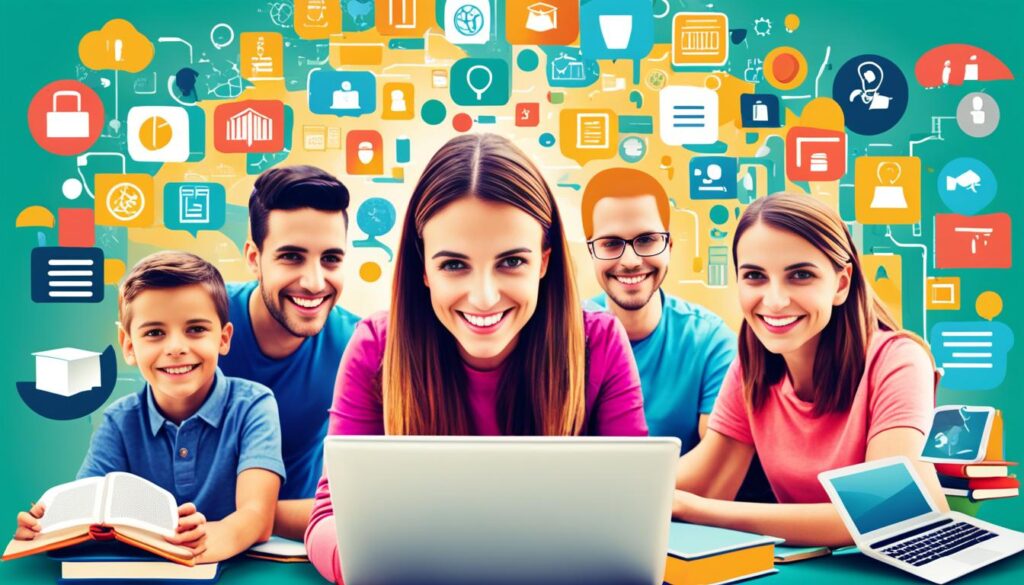
Overall, technology, exemplified by platforms like Coursera, has transformed the accessibility to quality higher education. By leveraging the power of online platforms and virtual classrooms, individuals can now pursue their educational goals, regardless of their circumstances. This advancement in technology has truly democratized education, making it accessible to learners around the world and empowering them to enhance their knowledge and skills.
Higher Education Excellence through Next-Gen EdTech Solutions
Next-generation educational technology solutions are revolutionizing the higher education landscape, paving the way for enhanced learning experiences and educational excellence. These innovative technologies are integrating seamlessly into traditional educational models, augmenting teaching methodologies, and empowering learners for success in a rapidly evolving digital world.
From interactive learning platforms to AI-powered virtual assistants, these next-gen EdTech solutions are designed to foster collaboration, engagement, and personalized learning. By harnessing the power of innovative technologies, students can access educational resources anytime, anywhere, and tailor their learning journey to suit their individual needs.
One cutting-edge example of a next-gen EdTech solution is the use of immersive virtual reality (VR) experiences to simulate realistic learning environments. Through VR, students can explore complex concepts, conduct virtual experiments, and engage in experiential learning that transcends traditional classroom boundaries. These immersive experiences not only enhance student engagement but also promote critical thinking and problem-solving skills.
Another transformative technology in higher education is the integration of artificial intelligence (AI) into learning platforms. AI algorithms can analyze student performance data, identify knowledge gaps, and provide personalized recommendations for targeted learning. This adaptive approach ensures that students receive tailored support, enabling them to achieve higher levels of educational excellence.
In addition to individualized learning experiences, next-gen EdTech solutions also promote collaboration and peer-to-peer interaction. Virtual learning environments, online discussion forums, and interactive multimedia tools facilitate effective communication and knowledge sharing among students, fostering a sense of community and collective learning.
The seamless integration of next-gen EdTech solutions into higher education institutions empowers educators to deliver transformative learning experiences that prepare students for future challenges. By embracing these innovative technologies, educational institutions can maximize their potential in creating a dynamic, engaging, and inclusive learning ecosystem that fosters higher education excellence.
Enriching Learning Environments with AR and VR Applications
In this section, we will discuss how augmented reality (AR) and virtual reality (VR) applications can enrich learning environments. These innovative technologies offer immersive learning experiences that have the potential to transform educational outcomes.
Immersive Experiences that Transform Educational Outcomes
AR and VR applications provide students with the opportunity to engage in realistic and interactive learning experiences. By using these technologies, students can explore virtual worlds, manipulate objects, and interact with simulations, enabling them to acquire knowledge and develop skills in a more hands-on and experiential manner.
AR enhances the real-world environment by overlaying virtual elements, such as 3D models, text, or animations, onto the user’s physical surroundings. This technology allows students to visualize complex concepts, such as anatomical structures or historical events, in a more interactive and tangible way. It enables them to explore and understand abstract ideas with greater clarity, fostering deeper understanding and retention.
VR, on the other hand, creates entirely immersive and simulated environments that transport students to different places, times, or scenarios. Through VR, students can visit historical landmarks, travel to outer space, or even dive into the depths of the ocean, all from the comfort of their classrooms. This level of immersion cultivates a sense of presence and emotional connection, enhancing student engagement and motivation.
Moreover, AR and VR applications facilitate personalized learning experiences tailored to individual students’ needs and learning styles. These technologies provide opportunities for interactive assessments, adaptive feedback, and customized content delivery, allowing educators to cater to diverse learners and address their specific strengths and challenges.
By incorporating AR and VR applications into the learning environment, educators can create transformative educational experiences that captivate and inspire students. These technologies have the potential to spark curiosity, ignite creativity, and foster a deep love for learning that extends beyond the traditional classroom.
Let’s explore some specific examples and use cases of AR and VR applications in education:
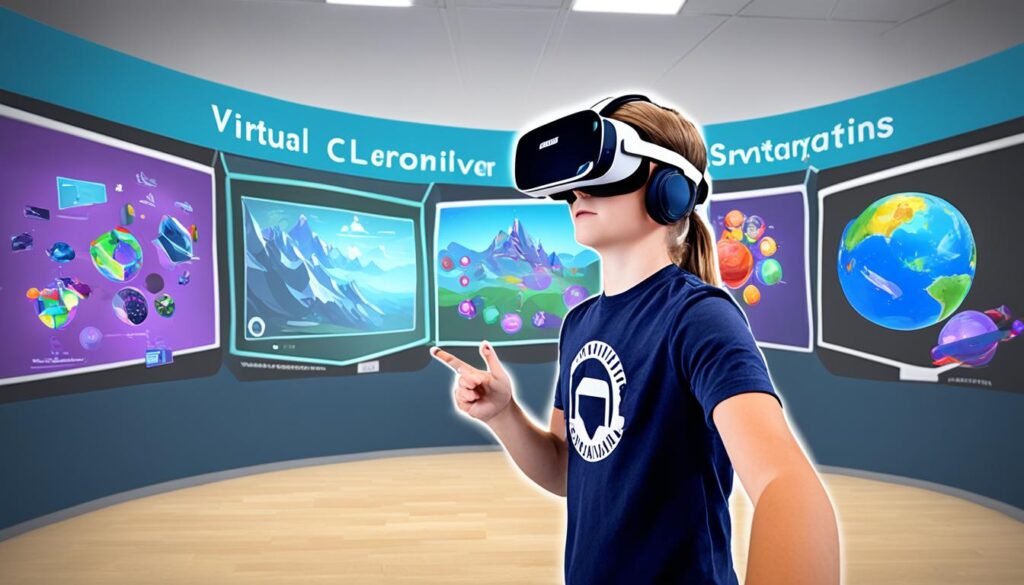
| AR and VR Applications in Education | Benefits |
|---|---|
| Virtual science labs | – Safe and cost-effective hands-on experiments – Realistic simulations of scientific phenomena – Enhanced understanding of abstract concepts |
| Historical virtual tours | – Immersive exploration of historical sites – Contextual understanding of significant events – Cultural and historical preservation |
| Language learning with AR | – Interactive vocabulary learning – Real-world language context – Pronunciation practice and feedback |
| Virtual field trips | – Access to remote or inaccessible locations – Engagement with diverse environments and cultures – Deepened global awareness and empathy |
These examples illustrate the wide range of possibilities when it comes to leveraging AR and VR applications in education. By embracing these technologies, educators can revolutionize traditional teaching approaches and unlock new opportunities for immersive, interactive, and transformational learning.
Innovative Teaching Models that Encourage Critical Thinking and Creativity
When it comes to modern education, innovative teaching models play a vital role in fostering critical thinking, creativity, and transformative learning experiences for students. These models go beyond traditional lecture-style teaching and actively engage students in the learning process, allowing them to develop essential skills that will contribute to their overall success in academia and beyond.
One such innovative teaching model is problem-based learning, which encourages students to actively solve real-world problems by applying critical thinking and creative problem-solving skills. Through this approach, students develop a deeper understanding of the subject matter while honing their analytical and decision-making abilities.
Another effective teaching model is project-based learning, where students work on hands-on projects related to the curriculum. This model allows students to explore their own interests, collaborate with peers, and think critically to find creative solutions to challenges. It not only enhances their subject knowledge but also fosters skills such as communication, teamwork, and time management.
By utilizing innovative teaching models, educators can create an environment that nurtures curiosity, exploration, and experimentation. These models provide students with the opportunity to take ownership of their learning, fostering independence and self-motivation.
Furthermore, incorporating technology into the classroom can greatly enhance these teaching models. Interactive online platforms, virtual reality applications, and collaborative tools offer students new and exciting ways to engage with educational content, encouraging critical thinking and creativity in the process.
To illustrate the impact of innovative teaching models, we can look at the growing popularity of educational games. Game-based learning integrates critical thinking and problem-solving skills into educational experiences, making learning enjoyable and engaging. Educational games such as Minecraft Education Edition and language learning apps like Duolingo have demonstrated significant success in fostering critical thinking, creativity, and knowledge retention among students.
To further explore the benefits of innovative teaching models, refer to the table below:
| Teaching Model | Benefits |
|---|---|
| Problem-Based Learning |
|
| Project-Based Learning |
|
| Game-Based Learning |
|
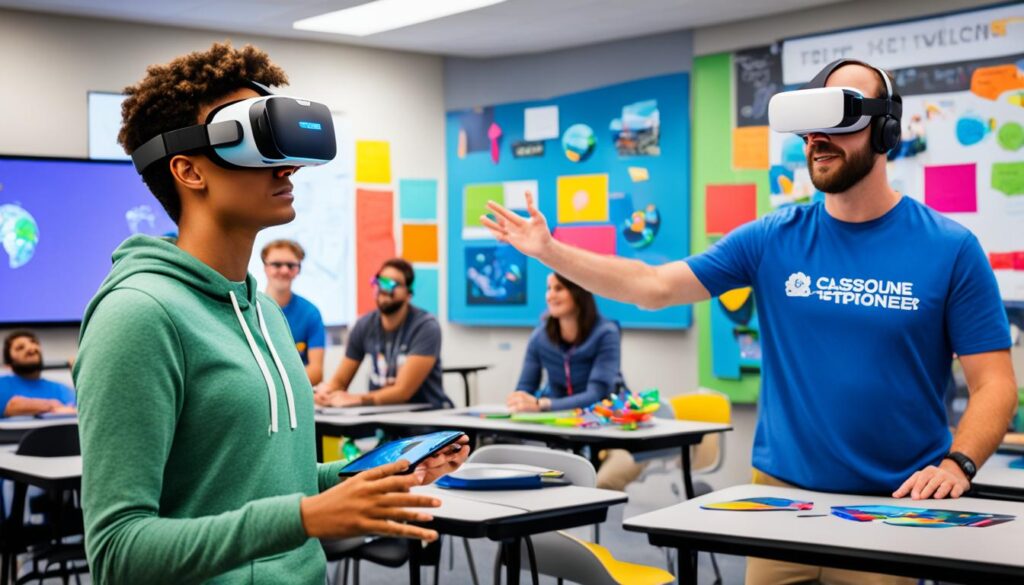
In conclusion, integrating innovative teaching models into classrooms is essential for fostering critical thinking, creativity, and transformative education. By embracing these models and leveraging technology, educators can create an enriched learning environment that empowers students to develop the skills necessary for success in the 21st century.
Conclusion
Embracing the Future of Learning with Open Collaboration
In conclusion, the future of learning holds immense potential for growth and innovation. One key aspect that will drive this evolution is open collaboration. By fostering an environment of collaboration, educational institutions, policymakers, and stakeholders can work together to shape the future of education. This collaborative approach will enable the development and implementation of innovative education models that are tailored to the needs of students in the 21st century.
Advancing Global Competitiveness through Innovative Education Models
Furthermore, embracing innovative education models is vital for advancing global competitiveness. As the world becomes increasingly interconnected, it is essential that educational systems adapt to meet the demands of a rapidly changing global landscape. By embracing innovative models, such as blended learning, personalized education, and game-based learning, educational institutions can equip students with the necessary skills to thrive in a competitive global economy.
In conclusion, the future of learning lies in open collaboration and the adoption of innovative education models. It is through collective efforts and a commitment to excellence that we can transform education and create a brighter future for learners worldwide. By embracing the future of learning, we can ensure that education remains relevant, inclusive, and impactful, preparing students for success in a rapidly evolving world.
FAQ
What is transformative learning?
Transformative learning refers to an educational approach that aims to create profound and lasting changes in students’ beliefs, attitudes, and perspectives. It goes beyond acquiring knowledge and skills, focusing on personal growth and development.
How does the U.S. Department of Education foster higher education excellence?
The U.S. Department of Education promotes higher education excellence through various initiatives. One such initiative is “Raise the Bar: Lead the World,” which seeks to advance educational equity and ensure all students have access to high-quality education. Additionally, the department focuses on implementing proven strategies for academic success that support educational excellence.
What are blended and online learning models?
Blended and online learning models are innovative approaches to educational delivery. Blended learning combines traditional face-to-face instruction with digital tools and resources, while online learning involves fully remote instruction through online platforms. These models offer flexible, personalized, and accessible learning experiences for students.
How do adaptive learning technologies personalize the educational journey?
Adaptive learning technologies use data analytics to tailor student learning experiences. By analyzing students’ strengths, weaknesses, and learning preferences, these technologies create personalized learning paths that cater to individual needs. Khan Academy is a notable example of a platform that has successfully implemented adaptive learning to enhance student engagement and achievement.
What is the impact of game-based learning on student engagement?
Game-based learning has proven to be a powerful tool for increasing student engagement. Minecraft Education Edition, for instance, allows students to explore, create, and collaborate in virtual environments, making learning more interactive and enjoyable. Similarly, language learning platforms like Duolingo incorporate gamification techniques to make language acquisition fun and engaging.
How does technology expand accessibility to quality higher education?
Technology plays a crucial role in expanding access to quality higher education. Platforms like Coursera provide online courses and degree programs that break down geographic barriers and allow learners to study at their own pace. Virtual classrooms facilitated by technology further democratize education by providing opportunities to interact and learn from experts and peers worldwide.
How do next-gen EdTech solutions contribute to higher education excellence?
Next-gen EdTech solutions are transforming higher education by offering innovative approaches to teaching and learning. These technologies leverage artificial intelligence, virtual reality, and data analytics to enhance student engagement, personalize instruction, and improve learning outcomes. By incorporating these solutions, higher education institutions can strive for academic excellence and stay at the forefront of education.
How do AR and VR applications enrich learning environments?
Augmented reality (AR) and virtual reality (VR) applications provide immersive experiences that enrich learning environments. AR overlays virtual elements onto the real world, allowing students to interact with content in a more tangible way. VR creates entirely virtual environments, enabling students to explore and experience complex concepts firsthand. These technologies enhance learning outcomes by making education more interactive and engaging.
What are innovative teaching models that encourage critical thinking and creativity?
Innovative teaching models foster critical thinking and creativity by shifting the focus from passive learning to active participation. Project-based learning, flipped classrooms, and inquiry-based learning are some examples of these models. They promote hands-on problem-solving, collaboration, and self-directed learning, enabling students to develop essential skills for success in the 21st century.
Why is embracing open collaboration important for the future of learning?
Embracing open collaboration is crucial because it promotes knowledge sharing, fosters creativity, and encourages diverse perspectives. By collaborating across disciplines, institutions, and even countries, educators and students can leverage collective expertise and resources to address complex challenges. Open collaboration also leads to the development and dissemination of innovative education models, ultimately advancing global competitiveness.
Source Links
- https://www.ed.gov/raisethebar/
- https://www.linkedin.com/pulse/innovation-education-transforming-way-we-learn-wearegoodinc
- https://medium.com/@fridaygg/unleashing-educational-excellence-with-edu3labs-transforming-learning-in-the-digital-age-a52410a14ea7

